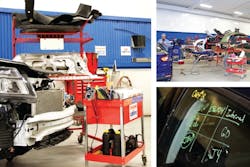Check Collision
SHOP: Check Collision LOCATION: Mattapoisett, Mass. OWNER: Paul Zammito
SIZE: 28,000 square feet STAFF: 30 ANNUAL REVENUE: $6 million
1) When Check Collision moved into a new facility, lead appraiser Luis Rebelo says they decided to revamp the entire repair process by ordering a fleet of 30 parts carts to organize and streamline the process.
“It really helped the entire process from beginning to end where everybody involved knew where they could find the parts to a certain car,” Rebelo says.
2) During the estimating process, estimators use wet-erase markers to color code each part. Rebelo says the shop uses the colors of a traffic light (red, yellow, green). Parts marked in red should not be touched, parts marked in yellow are pending approval, and parts marked in green can be used immediately. Any parts related to teardown are marked in blue.
“Prior to doing that, we may have ended up with a part being painted that wasn’t supposed to be touched, or repairs for something that was unrelated to the accident,” he says.
3) The cart is organized into three racks that designate what should happen with the part during the repair process. After the parts are color coded by the estimator, they are stored on their respective rack on the cart. The bottom rack is for any parts that are being replaced (it also designates those that need to be identified, photographed and added to the repair order in the management system). The middle rack is for parts that will be repaired, rather than replaced. The top rack is for parts that are taken off for the repair and put back on later.
4) Each cart has a rack of hooks, which are used to hold clear plastic bags containing small parts and hardware.
“If an appraiser wants to see broken hardware because we want to replace it, he can very easily find it,” Rebelo says. “And when the techs are putting the cars back together, they know everything is in this one bag. They’re not sitting there sorting through clips and screws.”
5) Equally as important as the organization is the storage of the carts in the shop. The shop uses one bay and the perimeter of the paint booth to store the carts. First, each cart was numbered 1-30. Then, the shop used bright yellow tape to create outlines for each cart on the floor. Each of those spots was numbered, dictating where the corresponding cart should be stored.
6) To clearly identify the cart number, the shop attached a white-erase “license plate” to each cart, which contains the cart number, customer’s last name, repair order number, and the vehicle make/model.
7) To ensure all staff members know the status of the vehicle, a tic-tac-toe grid is drawn on a window of each car with a wet-erase marker. The top left square contains the customer’s name and cart number.
